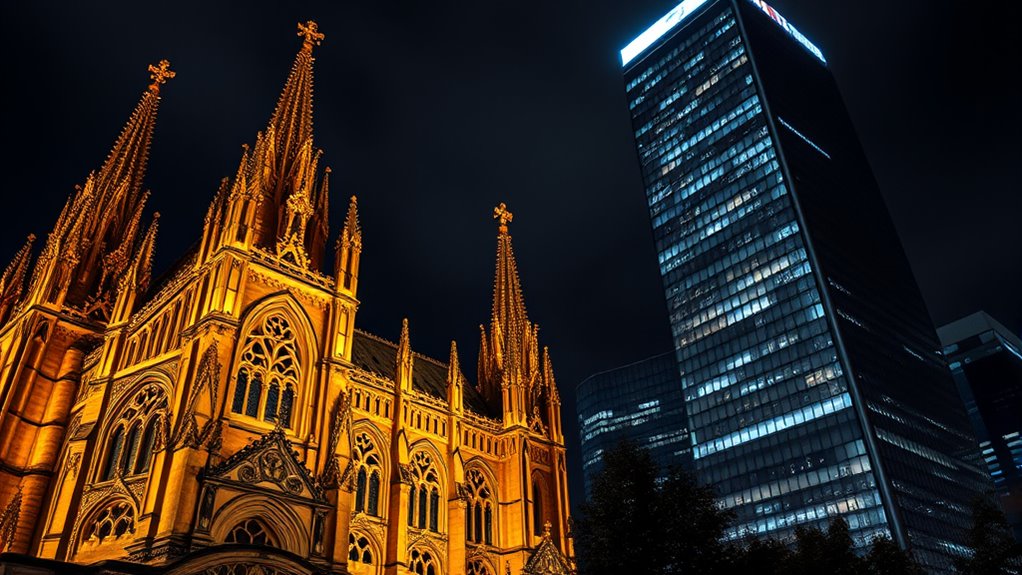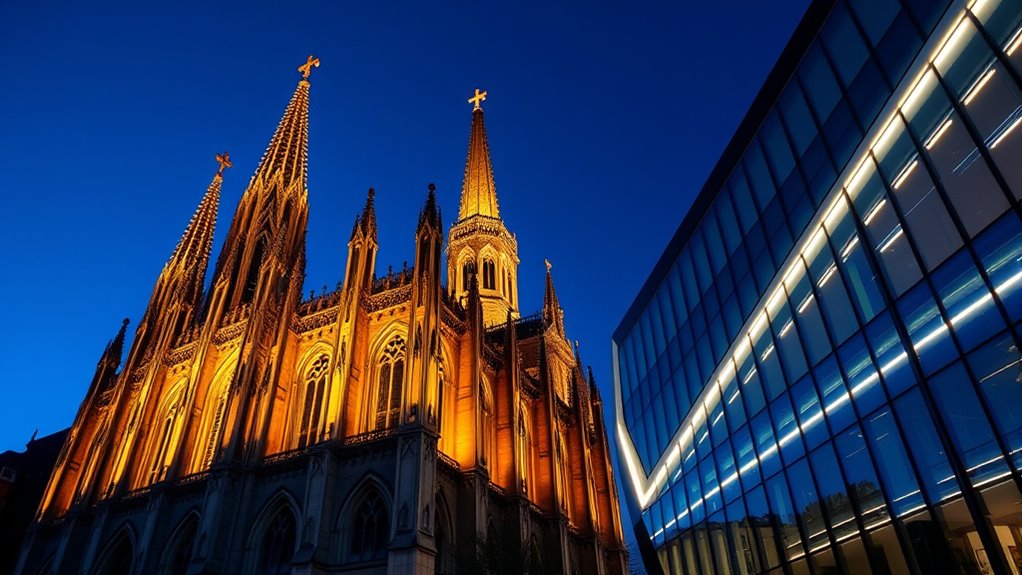Architectural lighting has evolved from Gothic stained glass that told stories and created spiritual awe to modern designs that emphasize sleek lines and energy efficiency. Today, innovative technologies like LED fixtures and smart controls blend seamlessly with traditional principles, highlighting architectural features while reducing environmental impact. This balance allows you to appreciate both historic craftsmanship and sustainable advancements. If you’re curious about how this progression continues to shape architectural lighting, there’s much more to explore.
Key Takeaways
- Gothic architecture used stained glass and candlelight techniques to create spiritual, storytelling illumination rooted in symbolism.
- Modern lighting integrates energy-efficient technologies like LEDs and smart controls, blending innovation with traditional aesthetics.
- Historical lighting focused on emotional and spiritual effects, emphasizing craftsmanship and symbolic storytelling.
- Contemporary design adapts traditional techniques with sustainable materials, enhancing architectural features across styles.
- Future trends aim to balance aesthetic appeal with energy efficiency, bridging historical principles with technological advancements.

Have you ever noticed how lighting transforms a building’s appearance after sunset? The way light interacts with architecture can highlight intricate details, create mood, and even redefine space. Throughout history, lighting has evolved alongside architectural styles, from the grandeur of Gothic cathedrals to sleek modern designs. In earlier eras, architects relied heavily on natural lighting during the day, but as structures grew more complex, they began incorporating lighting techniques that emphasized craftsmanship and symbolism. Historical techniques, such as the use of stained glass windows in Gothic architecture, served dual purposes: illuminating interiors and telling stories through colorful, filtered light. These methods weren’t just about visibility; they aimed to evoke emotion and spiritual awe. Fast forward to today, and there’s a conscious shift toward sustainable solutions that align with environmental values. Modern architectural lighting integrates energy-efficient technologies, such as LED fixtures and smart controls, reducing carbon footprints while maintaining aesthetic appeal. These sustainable solutions also include the use of renewable energy sources, like solar-powered lighting systems, which minimize reliance on nonrenewable resources. As you explore different buildings, you’ll notice how contemporary designers blend these innovations seamlessly with traditional principles, creating a dialogue between past and present. For instance, some historical techniques are being adapted using modern materials to enhance energy efficiency without losing their original charm. Think about how LED lights can mimic the warm glow of candlelight or gas lamps, paying homage to historical ambiance while offering sustainability. This evolution reflects a broader understanding that architectural lighting isn’t just about illumination; it’s about creating a sustainable future while respecting historical roots. You’ll also see how lighting plays a key role in emphasizing architectural features—be it the soaring arches of a Gothic cathedral or the clean lines of modernist buildings. In both cases, lighting helps define the structure’s identity and purpose. With advancements in technology, you now have the ability to control lighting precisely to suit different times of day or events, further improving energy efficiency and user experience. Additionally, lighting design techniques are evolving to combine aesthetics with energy efficiency, ensuring that beauty and sustainability go hand in hand. Whether it’s highlighting ornate facades or providing subtle ambiance, the progression from traditional techniques to sustainable solutions shows a commitment to innovation rooted in history. As you observe the interplay of light and architecture, it’s clear that lighting is an essential element that evolves with societal values and technological progress, bridging centuries of design philosophy into the future.
Frequently Asked Questions
How Has LED Technology Influenced Modern Architectural Lighting Designs?
You’ve seen how LED technology has transformed modern architectural lighting through LED integration and lighting automation. It allows you to create dynamic, energy-efficient designs that adapt seamlessly to your needs. With LEDs, you can achieve precise control over brightness, color, and ambiance, making your spaces more functional and visually striking. This technology empowers you to innovate effortlessly, blending sustainability with aesthetic appeal in your architectural projects.
What Are the Environmental Impacts of Different Architectural Lighting Options?
You should consider that different architectural lighting options impact the environment by affecting energy consumption and light pollution. Energy-efficient choices like LED lighting reduce electricity use, helping lower carbon footprints. However, poorly designed lighting can increase light pollution, disrupting ecosystems and obscuring night skies. By selecting eco-friendly fixtures and directing light thoughtfully, you can minimize environmental harm while still achieving stunning architectural effects.
How Do Cultural Differences Affect Architectural Lighting Choices Worldwide?
Cultural differences shape architectural lighting choices like a tapestry, weaving symbolism and aesthetics into every design. You’ll find that lighting reflects local customs, beliefs, and values, making spaces feel authentic and meaningful. For instance, in some cultures, warm lighting symbolizes hospitality, while in others, bright, cool tones highlight modernity. Understanding these cultural symbols helps you create lighting that resonates deeply, enriching the building’s identity and connection to its community.
What Are the Latest Innovations in Sustainable Architectural Lighting Solutions?
You should explore the latest in sustainable architectural lighting solutions, like smart automation and material advancements. Smart automation allows you to optimize energy use with sensors and programmable controls, reducing waste. Material advancements, such as eco-friendly LEDs and recyclable components, help you create eco-conscious designs. By integrating these innovations, you can enhance energy efficiency, reduce environmental impact, and achieve modern, sustainable lighting that aligns with your project’s sustainability goals.
How Can Architectural Lighting Enhance Safety and Security in Public Spaces?
You can enhance safety and security in public spaces by using strategic lighting that emphasizes tonal contrast and shadow play. Studies show well-designed lighting reduces crime rates by up to 20%. By creating areas with clear visibility and interesting shadow patterns, you guide pedestrians safely while deterring potential threats. Properly placed lights not only improve navigation but also foster a sense of security, making public spaces more welcoming and safer for everyone.
Conclusion
As you step back, you see how lighting transforms a building’s soul—casting shadows that dance like Gothic whispers or illuminating sleek modern lines with a radiant glow. From flickering candlelight to crisp LEDs, each choice paints a different mood, shaping how you experience space. lighting is the artist’s brush, turning cold stone into warm stories. Embrace its power, and watch your surroundings come alive, whispering tales from ancient vaults to futuristic skylines.









